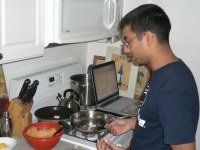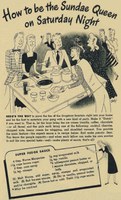Prairie Fare: Where Do You Get Your Recipes?
(Click an image below to view a high-resolution image that can be downloaded)
By Julie Garden-Robinson, Food and Nutrition Specialist
NDSU Extension Service
“Let’s start cooking!” I said with enthusiasm to my daughter.
“Mom, what’s the difference between cooking and baking?” my 11-year-old daughter asked.
We were about to bake some bread, so I think she was associating cookies and breads with baking.
My husband chuckled when he saw me wrinkling my brow and pondering her question. Is baking a subset of cooking, or are they completely different?
“Baking is a science and cooking is an art,” I replied. I needed to say something quickly while I double-checked my initial thoughts.
That wasn’t the answer she was seeking. Her hands were on her hips and she was looking at me with a skeptical expression on her face.
I grabbed my computer tablet and started looking up culinary terms. I propped my computer tablet in my new tablet holder and set it on the kitchen countertop. I didn’t want to get flour on it while we were on our culinary adventure.
My daughter giggled as she watched me perusing websites and said, “Well, Mom, you could write a column about it.”
Although the terminology sometimes is debated, cooking is the general term for a wide range of food preparation practices, and baking falls under the overall “cooking” umbrella. Baking usually refers to preparing food with dry heat in an oven, so it includes cookies as well as baked potatoes.
That answer satisfied my daughter, but her question made me think about how people access information about food and recipes.
Even though cookbooks remain bestsellers, people aren’t necessarily thumbing through pages in a book when they have questions about food. You might be reading this column in a newspaper. Maybe you received it in an email message or on your cellphone screen. You might have accessed it via an RSS feed, as a Tweet on Twitter or as a link on Facebook.
By the way, however you are reading this column, I appreciate it.
The Hartman Group, which does consumer research, conducted a study called “Clicks and Cravings: The Impact of Social Technology on Food Culture.” Half of the people who responded to the national phone survey said they use social media, such as Facebook, to learn about food. About 40 percent visit blogs or websites or use apps to learn about food.
Yes, we have a lot of information about food available, and the technology makes it easy to access if you are interested in using the technology. Although I enjoy using technology, I have a large collection of cookbooks, too. I also use my computer tablet holder to prop up my cookbooks and hold my well-worn family recipe cards.
Is having access to all of these recipes making us eat more healthfully? Not necessarily. We do not know the full impact of technology on our diet decisions. Fortunately, I do not absorb calories through my fingertips from the screen of my technology as I peruse food information online.
Regardless of how you access your recipes, how can you evaluate their healthfulness? These are some tips:
- Look for nutrition information included with the recipe. Be sure to check the serving size because if you eat three servings, you are getting three times the calories, protein, carbohydrate, fat and other nutrients. That’s not necessarily a good thing.
- Check out the recipe ingredients. A healthful diet includes a variety of foods, so try to include a vegetable, fruit, protein, grain and milk on your lunch and dinner menus and at least three of the five food groups on your breakfast menu.
- What is the cooking method? Baking, grilling and broiling are lower-fat, lower-calorie methods compared with frying or deep-frying. However, stir-frying is a low-fat method because a small amount of oil or broth is used.
- To learn about recipe modification, see “Now Serving: Recipe Makeovers” (available at http://www.ag.ndsu.edu/pubs/yf/foods/fn1447.pdf). The publication shows how to decrease total calories and sodium, and increase fiber in your favorite recipes. Visit http://www.ag.ndsu.edu/food and check out the recipe database and our “Nourishing Boomers and Beyond” program for people 50-plus.
Regardless of what you choose to prepare and how you cook it, make your dining experience a pleasant one because food is something to enjoy. Here’s a fiber-rich muffin recipe that includes whole-grain, vegetable and fruit ingredients.
Reduced-fat Morning Glory Muffins
1 c. all-purpose flour
1 c. whole-wheat flour
3/4 c. sugar
2 tsp. baking soda
2 tsp. ground cinnamon
1/4 tsp. salt
2 c. chopped apples (unpeeled)
1/2 c. raisins (or dried cranberries)
3/4 c. grated carrots
2 Tbsp. chopped pecans (optional)
3 eggs (or 3/4 c. egg substitute)
1/2 c. canola oil
1/2 c. unsweetened applesauce
2 tsp. vanilla extract
Preheat the oven to 350 F. Sift or whisk together flour, sugar, baking soda, cinnamon and salt in a large bowl. Add the apples, raisins, carrots and nuts (if desired) and stir to combine. In a separate bowl, whisk the eggs with the oil, applesauce and vanilla. Combine the wet and dry ingredients. Spoon the batter into muffin tins lined with muffin cups (or sprayed with cooking spray). Fill fairly full. Bake for 30 to 35 minutes or until a toothpick inserted into the middle comes out clean. Cool muffins in the pan for 10 minutes, then turn out onto a rack to continue cooling.
Makes 18 muffins. Each muffin has 170 calories, 7 grams (g) of fat, 3 g of protein, 25 g of carbohydrate, 2 g of fiber and 200 milligrams of sodium.
(Julie Garden-Robinson, Ph.D., R.D., L.R.D., is a North Dakota State University Extension Service food and nutrition specialist and professor in the Department of Health, Nutrition and Exercise Sciences.)
NDSU Agriculture Communication – Feb. 26, 2015
| Source: | Julie Garden-Robinson, (701) 231-7187, julie.garden-robinson@ndsu.edu |
|---|---|
| Editor: | Rich Mattern, (701) 231-6136, richard.mattern@ndsu.edu |



